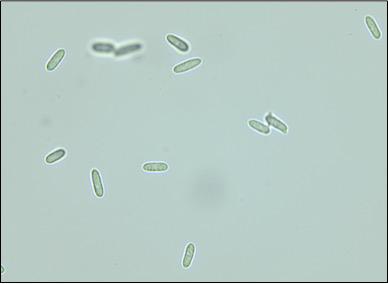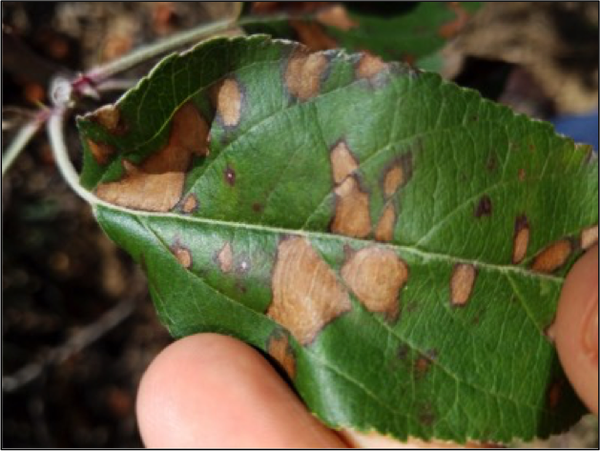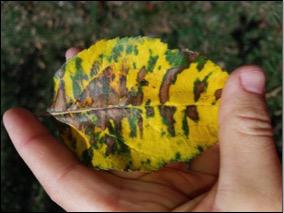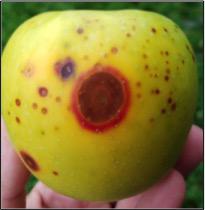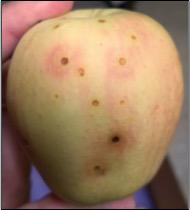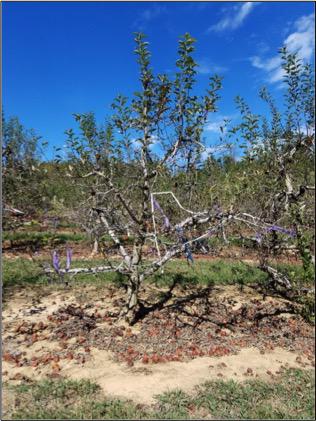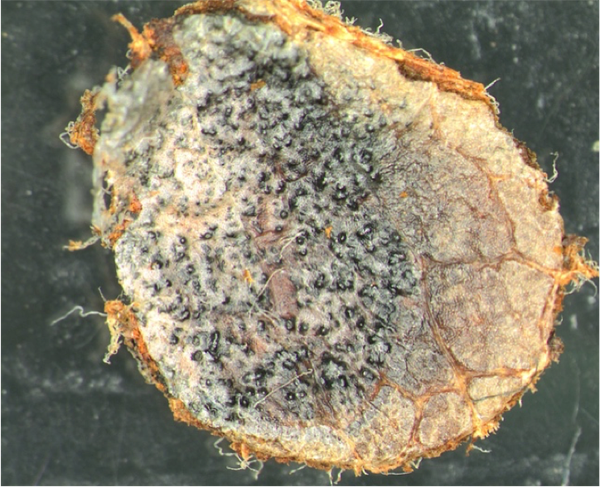Introduction
Glomerella leaf spot and fruit rot is a devastating fungal disease of apple that results in premature defoliation and diminished fruit quality or unmarketable fruit. Additionally the disease may cause decreased winter hardiness and reduced crop return. While Glomerella leaf spot and fruit rot must be managed annually in North Carolina, other apple growing regions in the eastern United States have reported occasional outbreaks during hot and humid growing seasons.
Pathogen
Glomerella leaf spot and fruit rot is caused by fungi in the Colletotrichum gloeosporioides species complex.
Symptoms and Signs
Symptoms of the leaf spot stage of the disease begin as tiny purple flecks or specks on the front of the leaf. In the absence of fungicide intervention, the purple flecks rapidly expand into irregularly shaped, often concentric, lesions. Later in the infection process, leaves become chlorotic (yellow) and drop prematurely prior to harvest. Most commonly, early symptoms of Glomerella leaf spot will appear within the lower inner tree canopy, however, initial disease symptoms have been observed on terminal leaves and high in the canopy. Glomerella fruit rot symptoms initially appear as small sunken lesions on either immature or mature fruit and are slightly larger than the size of a lenticel. The lesion may expand prior to or post-harvest and can evolve into a full rot. On yellow skinned cultivars at harvest, a red halo can be observed surrounding the rot lesion. Unlike more typical bitter rot symptoms, salmon colored sporulation is rarely to never observed with Glomerella fruit rot.
Environmental Conditions Favoring Disease
Hot and humid conditions favor infection by the Collectotrichum fungi causing Glomerella leaf spot and fruit and disease development. Infection by conidia occurs between 59°F and 95°F, with an optimal temperature of 82°F. A minimum 2.76 hours of leaf wetness are required for infection to occur.
Sources of Inoculum
Research regarding the sources of inoculum for Glomerella leaf spot and fruit rot is currently being conducted. The main source of primary inoculum for the disease appears to be infected leaves overwintering on the orchard floor. Ascospores are released from perithecia sometime around the blom / petal fall growth stage. The development of perithecia on infected / fallen leaves has not been observed in North Carolina during the growing season. Other sources of Glomerella leaf spot and fruit rot inoculum that are currently being investigated include cankers, buds, mummified fruit, and other plant hosts.
Management
Once the disease is observed in the orchard, Glomerella leaf spot and fruit rot can be difficult to control. Management, therefore should be focused on prevention and consist of a combination of cultural and chemical interventions.
Cultural
- Pruning and removal of shoots inected with fire blight, dead wood, wood with cankers, and fruit mummies
- Post-harvest application of urea, flail mowing, and / or leaf removal to reduce overwintering inoculum
- Increase air-flow through the canopy to reduce trying time and decrease humidity within the canopy
- Plant less susceptible/resistant cultivars. Cultivars with 'Golden Delicious' parents tend to be most susceptible to Glomerella leaf spot and fruit rot.
Fungicides
In North Carolina, fungicide programs to manage Glomerella leaf spot and fruit rot should begin at petal fall and continue on 7 to 14 day intervals through harvest. It is suggested that single-site fungicides be applied in tank mixture with a multi-site protectant for resistance management. The table below lists active ingredients / products that have demonstrated high levels of efficacy in field trials at NC State. A more comprehensive list of registered fungicides for Glomerella leaf spot and fruit rot management may be found in the Integrated Orchard Management Guide for Commercial Apples in the Southeast. Please note that fungicide labels are legal documents-always read and follow label directions.
| Active ingredient | Example Formulated Product | Pre-harvest inteveral (days) | FRAC Code |
|---|---|---|---|
| Mancozeb | Koverall | 77 (3 lb/A rate only) | M3 |
| Captan | Captan 80WDG | 0 | M4 |
| Trifloxystrobin | Flint 50WG | 14 | 11 |
| Trifloxystrobin + Fluopyram | Luna Sensation | 14 | 11 + 7 |
| Pyraclostrobin + Fluxapyroxad | Merivon | 0 | 11 + 7 |
| Pyraclostrobin + Boscalid | Pristine WG | 0 | 11 + 7 |
| Potassium Phosphite | Prophyt | 0 | 33 |
| Ziram | Ziram 76DF | 14 | M3 |
| Fluazinam | Omega 500F | 28 | 29 |
Publication date: June 5, 2017
Recommendations for the use of agricultural chemicals are included in this publication as a convenience to the reader. The use of brand names and any mention or listing of commercial products or services in this publication does not imply endorsement by NC State University or N.C. A&T State University nor discrimination against similar products or services not mentioned. Individuals who use agricultural chemicals are responsible for ensuring that the intended use complies with current regulations and conforms to the product label. Be sure to obtain current information about usage regulations and examine a current product label before applying any chemical. For assistance, contact your local N.C. Cooperative Extension county center.
N.C. Cooperative Extension prohibits discrimination and harassment regardless of age, color, disability, family and marital status, gender identity, national origin, political beliefs, race, religion, sex (including pregnancy), sexual orientation and veteran status.

